The Agony of the Third Reich. 75 years of the Vistula-Oder operation
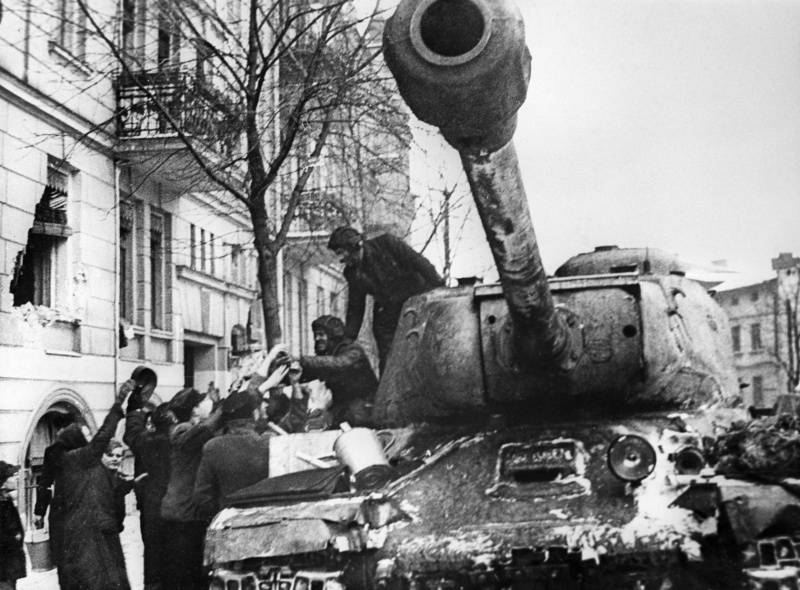
75 years ago, the Vistula-Oder offensive operation began, one of the most successful and large-scale offensives of the Red Army during the Great Patriotic War. Soviet troops liberated a significant part of Poland west of the Vistula, captured the bridgehead on the Oder and ended up 60 km from Berlin.
The situation on the eve of the offensive
By the beginning of 1945, the military-political situation in the world and in Europe had developed in favor of the countries of the anti-Hitler coalition. The grand victories of the Soviet Union over the German bloc in 1944 had a decisive influence on the further development of World War II. The Third Reich was left without allies. Italy, Romania, Bulgaria and Finland left the Nazi bloc and entered the war with Germany. The Allies maintained a strategic initiative. Since the summer of 1944, Berlin has been fighting on two fronts. The Red Army was advancing from the east, and the Americans, British and French from the west.
In the West, allied forces cleared the Nazis from France, Belgium, Luxembourg and part of Holland. The Western Front line ran from the mouth of the Meuse River in Holland and further along the Franco-German border to Switzerland. The allies here had complete superiority in forces: 87 fully-equipped divisions, 6500 tanks and over 10 thousand aircraft against the German 74 weak divisions and 3 brigades, about 1600 tanks and self-propelled guns, 1750 aircraft. The superiority of the allies in manpower and means was: in manpower - 2 times, in the number of tanks - 4, combat aircraft - 6 times. And this superiority has been constantly growing. In addition, the German high command held the most combat formations on the Russian front. On the Italian front, the allied forces were stopped by the Germans at the turn of Ravenna, Pisa. It operated 21 divisions and 9 brigades against 31 divisions and 1 brigade of Germans. The Germans also held 10 divisions and 4 brigades in the Balkans, against the People's Liberation Army of Yugoslavia.
In total, in the West, Berlin held about a third of its forces. The main forces and means still fought in the East, against the Russian armies. The eastern front remained the main front of the world war. The Anglo-American High Command, after a forced stoppage of the offensive, was about to resume movement and quickly break into the depths of Germany. The Allies planned to forestall the Russians in Berlin and to advance in some parts of Central Europe. In this England and the United States contributed to the leadership strategy of the Third Reich, which continued to hold its main forces and means on the Russian front.
The agony of the Third Reich
The situation in Germany was catastrophic. In the gigantic battles in the East, the Germans were defeated, suffered irreparable losses in manpower and equipment. The main strategic groups of the Germans on the Eastern Front were defeated, the strategic reserves of the Wehrmacht were depleted. The German armed forces could no longer regularly and fully receive replenishment. Berlin's strategic defense plan collapsed. The Red Army continued the victorious offensive. The military-economic potential of the German Empire sharply decreased. The Germans lost almost all previously captured territories and resources of the satellite countries. Germany was deprived of sources of strategic raw materials and food. German military industry still produced a large number weapons and technology, but already at the end of 1944, military production decreased significantly and at the beginning of 1945 continued to fall.
However, Germany was still a strong adversary. The German people, although they had lost hope of victory, were loyal to Hitler, retained the illusions of a "honorable world" if they "survive" in the East. The German armed forces totaled 7,5 million people, the Wehrmacht included 299 divisions (including 33 tank and 13 motorized) and 31 brigades. German troops retained high combat efficiency, could inflict strong and skillful counterattacks. He was a strong, experienced, and cruel adversary to be reckoned with. Military factories hid underground and in the rocks (from the blows of the Allied aviation) and she continued to supply troops with weapons and ammunition. The technical potential of the Reich was high, the Germans until the end of the war continued to improve aircraft, produce new heavy tanks, guns and submarines. The Germans created a new long-range weapon - jet planes, FAU-1 cruise missiles, and FAU-2 ballistic missiles. The infantry was armed with Faust cartridges - the first anti-tank grenade launchers, very dangerous in close and urban combat. Moreover, during the 1944 campaign, the length of the Soviet-German front was significantly reduced. This allowed the German command to consolidate battle formations.
The military-political leadership of the Third Reich was not going to lay down their arms. Hitler continued to bet on the split of the anti-Hitler coalition. The union of imperialist powers (England and the USA) with Soviet Russia was unnatural. The Anglo-Saxons at the beginning of the World War made a bet on the destruction of the USSR by Hitler, and then they were going to finish off weakened Germany, crush Japan and establish their own world order. Therefore, the West did its utmost to delay the opening of the second front, that the Russians and Germans bled each other as much as possible. However, these plans failed. The Red Army smashed the Wehrmacht and the Russians began to liberate Europe. If the allies had not landed in France, then the Russians could well have entered Paris again. Now England and the United States sought to get ahead of the Russians in Berlin, and occupy as much territory as possible in Europe. But the contradictions between the democracies of the West and the USSR have not disappeared. At any moment, a new world war could erupt - the Third.
Therefore, Hitler and his entourage tried with all their might to drag out the war, turning Germany into a besieged fortress. It was hoped that the Anglo-Saxons and Russians were about to cling to each other, and the Reich would be able to avoid complete defeat. Secret negotiations were conducted with the Westerners. Part of Hitler’s entourage was ready to either remove or surrender the Führer in order to negotiate with the West. To preserve the fighting spirit of the Wehrmacht and at least somehow support the faith of the population in the Fuhrer, German propaganda spoke of a "miracle weapon" that would soon appear and crush the enemies of the Reich. The German "gloomy genius" really led the development of atomic weapons, but the Nazis did not have time to create it. At the same time, total mobilization continued, formed a militia (Volkssturm), the elderly and young men were thrown into battle.
The basis of military plans was a tough defense. It was obvious to German generals that, from the perspective of a great strategy, the war was lost. The only hope is to keep your lair. The main danger came from the Russians. It was impossible to agree with Moscow after the shed blood. Therefore, in the East they planned to stand to death. On the Russian front were the main forces and the best divisions. The front line only in East Prussia passed on German soil. Also in Northern Latvia, the Army Group North was blocked (34 divisions). The Germans still held defenses in Poland, Hungary, Austria and Czechoslovakia. This was the huge strategic foreground of the Wehrmacht, on which Berlin hoped to keep the Russians away from the vital centers of the Third Reich. In addition, these countries had vital resources for the Reich, industrial and rural potential necessary to continue the war. With all this in mind, the German High Command decided to keep the existing borders, and to launch powerful counterattacks in Hungary. To create a solid defense, reinforced construction of fortifications was carried out, cities were turned into fortresses, and they were prepared for all-round defense. In particular, seven defensive lines up to 500 km deep (between the Vistula and the Oder) were built in the central, Berlin direction. A powerful defense line was in East Prussia, built on the former German-Polish and southern borders of the Reich.
But Berlin still hoped to find a common language with the West, using the slogan of the “red threat” - “Russians are coming!” It was necessary to show England and the USA their strength, the need for a future struggle with Soviet Russia. Taking advantage of the temporary lull on the fronts, Berlin organized a powerful blow on the Western Front, in the Ardennes. On December 16, 1944, three German armies of Army Group B launched an offensive on the northern section of the Western Front. The Germans showed the Allies how much a pound of dashing. The situation was critical. There was even a fear that the Nazis would break through to the English Channel and arrange a second Dunkirk for the Allies. Only the lack of strong reserves did not allow the Germans to develop their first success. Berlin showed its power to the Anglo-Saxons, but did not strike at full strength (for this, the armies in the East would have to be weakened). Thus, the German leadership demonstrated the strength of the Reich, hoping for a separate peace with the West, after which it would be possible to turn bayonets against Russia together.
In the future, the German high command was no longer able to organize powerful strikes in the West. This was due to events in the East. In December 1944, Soviet troops surrounded a powerful Budapest enemy group (180 thousand people), which forced the Germans to transfer forces from the Western Front to the Eastern. At the same time, Hitler’s Headquarters learned that the Red Army was preparing an offensive on the Vistula, in the main, Berlin direction, and in Prussia. The German High Command began to prepare the transfer of the 6th SS Panzer Army and other units from West to East.
At the same time, the Nazi leadership was mistaken in assessing the forces of the Red Army and in the direction of the main attack. The Germans expected the Russians to resume the offensive in the winter of 1945. However, taking into account the severity and bloodshed of the battles of 1944, Berlin believed that the Russians would not be able to attack all along the front. Hitler’s headquarters believed that the Russians would strike the main blow again in the southern strategic direction.
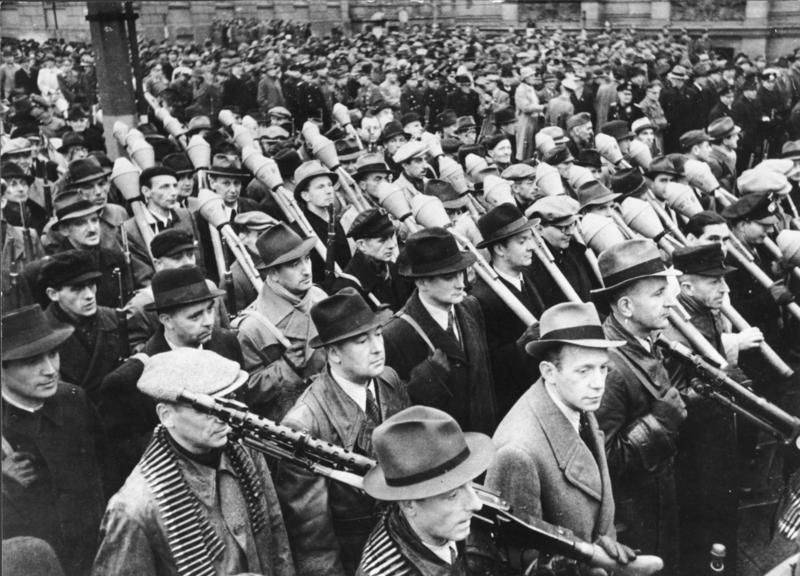
Moscow plans
The Red Army was preparing during the 1945 campaign to finish off the Third Reich and complete the liberation of the European countries enslaved by the Nazis. By the beginning of 1945, the military-economic power of the Union had increased even more. The economy developed in an ascending line, the most difficult tests in the development of the Soviet rear were left in the past. The economy was restored in the liberated regions of the country, metal smelting, coal mining, and electricity generation increased. Particular success was achieved in engineering. The Soviet socialist in the most difficult and terrible conditions showed its effectiveness and enormous opportunities, defeating the Nazi "European Union".
The troops were provided with everything necessary. Modernized combat aircraft, tanks, self-propelled guns were put into service. The growth of the country's economy led to an increase in the power of the Red Army, a sharp increase in its motorization and equipping with technical and engineering means. So, in comparison with the beginning of 1944, the saturation of military equipment increased: more than 2 times for tanks, 1,7 times for planes. At the same time, the troops had high morale. We smashed the enemy, freed our land, went to storm German strongholds. Significantly increased the level of combat skill of both ordinary and command personnel.
In early November 1944, the Soviet Headquarters decided to temporarily switch to the defense of the troops of the 2nd and 1st Belorussian and 1st Ukrainian Fronts, acting against the main strategic group of the Wehrmacht - the Warsaw-Berlin direction. For the development of this offensive, careful preparation was required, the creation of the necessary superiority of forces and means. At the same time, the offensive was planned to develop in a southerly direction, in the strip of the 3rd, 2nd and 4th Ukrainian fronts. The defeat of the German group in the Budapest region was supposed to weaken the enemy’s defense in the central sector of the Soviet-German front.
As a result, it was decided at the first stage to intensify actions on the flanks, in the south - in Hungary, then in Austria, and in the north - in East Prussia. Offensive operations on the flanks of the front that unfolded in November and December led to the Germans throwing their reserves there and weakening the troops in the main Berlin direction. At the second stage of the campaign, they planned to deliver powerful blows all over the front, defeating enemy groups in East Prussia, Poland, the Czech Republic, Hungary, Austria and Germany, taking the main vital centers, Berlin, and forcing them to surrender.
The forces of the parties
Initially, the start of operations in the main area was planned for January 20, 1945. But the start date of the operation was postponed to January 12 in connection with the problems of the Anglo-American troops in the West. On January 6, British Prime Minister Winston Churchill addressed Joseph Stalin. He asked Moscow to begin a major operation in the coming days, in order to force the Germans to transfer part of their forces from the Western to the Eastern Front. The Soviet Headquarters decided to support the allies, since the offensive was already being prepared.
Fulfilling the order of the Headquarters of the Supreme High Command (SVKK), the troops of the 1st Belorussian and 1st Ukrainian fronts under the command of Marshals Zhukov and Konev went on the offensive from the Vistula border. Soviet troops had a great advantage over the enemy in forces and means. Two Soviet fronts had over 2,2 million people, 34,5 thousand guns and mortars, about 6,5 thousand tanks and self-propelled guns, and about 4,8 thousand aircraft.
The Soviet Army in Poland was opposed by the German Army Group “A” (“Center” from January 26), which combined the 9th and 4th Panzer Armies, as well as the main forces of the 17th Army. They had 30 divisions, 2 brigades and several dozen separate battalions (garrisons of cities). A total of about 800 thousand people, about 5 thousand guns and mortars, more than 1,1 thousand tanks. The Germans prepared between the Vistula and the Oder seven defense lines, with a depth of up to 500 km. The first was the strongest - the Vistula defensive line, which consisted of four bands with a total depth of 30 to 70 km. Best of all, the Germans strengthened the areas in the areas of Magnushevsky, Pulawsky and Sandomierz bridgeheads. Subsequent defensive lines consisted of one or two lines of trenches and separate strong points. The sixth defensive line passed along the old German-Polish border, and had a number of fortified areas.
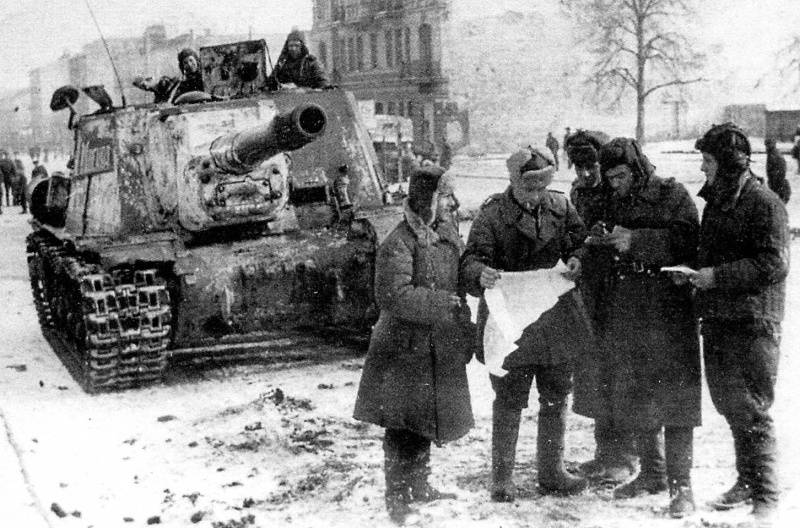
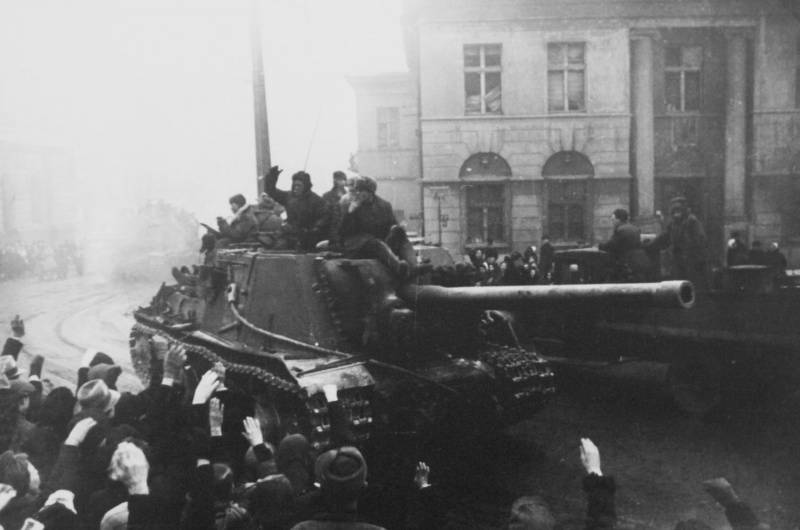
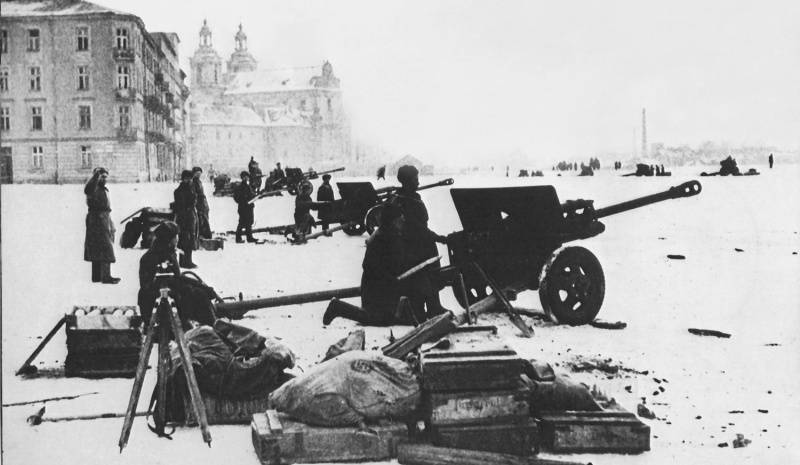
Wisla Oder
The 1st Ukrainian Front (UV) went on the offensive on January 12, 1945, the 1st Belorussian (BF) on January 14. Having broken through the enemy’s main line of defense at the Wislen line, the shock groups of two fronts began to rapidly break through to the west. Konev’s troops, which were operating from the Sandomierz bridgehead towards Breslau (Wroclaw), in the first four days advanced 100 km in depth and occupied Kielce. Particularly successful were the 4th Panzer, 13th Guards and 13th Armies of Generals Lelyushenko, Gordov and Pukhov. On January 17, the troops of the 3rd Guards Tank, 5th Guards, and 52nd Armies Rybalko, Zhadov, and Koroteev took the large Polish city of Czestochowa.
A feature of the operation was that the offensive of the Soviet armies was so swift that rather large enemy groups and garrisons remained in the rear of the Red Army. The advanced units rushed forward, not being distracted by the creation of a dense ring of encirclement, second echelons were engaged in the encircled enemy. That is, the 1941 situation was repeating in some respects. Only now the Russians were quickly advancing, and the Germans fell into the "cauldrons". Due to the high speed of the offensive, our troops quickly overcame the intermediate defense line along the Nida River and immediately crossed the Pilitsa and Warta rivers. Our troops reached the borders of these rivers even earlier than the retreating Nazis, who were moving in parallel. By the end of January 17, 1945, an enemy defense breakthrough was carried out along the front by 250 km and in depth by 120 - 140 km. During these battles, the main forces of the 4th Panzer Army, the 24th Tank Reserve Corps were defeated, and the 17th Army suffered great damage.
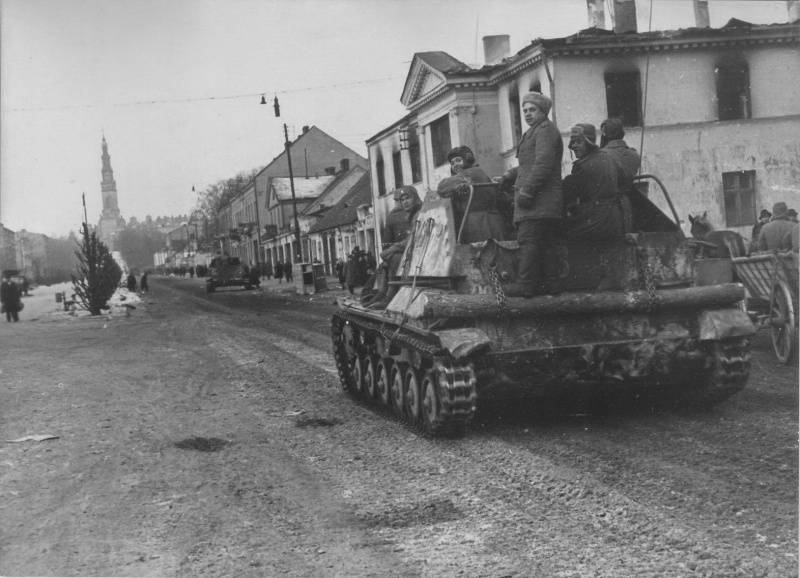
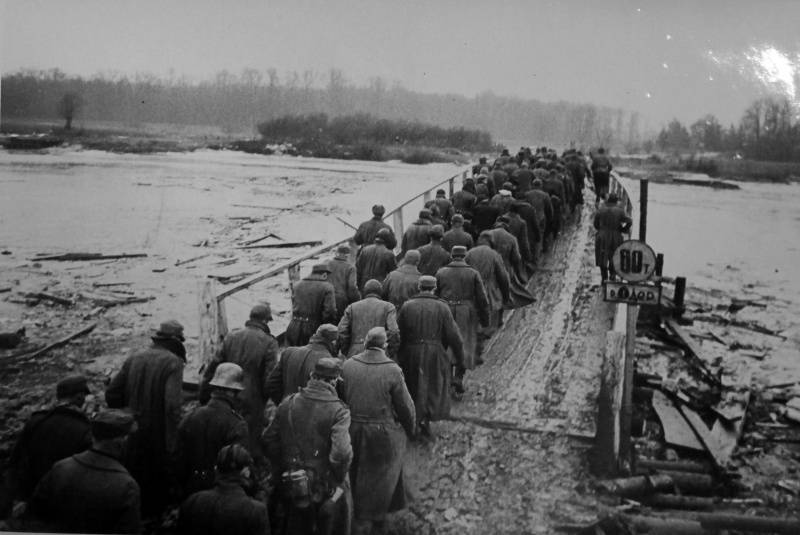
The troops of the 1st BF struck the main blow from the Magnushevsky bridgehead in the general direction to Poznan and at the same time from the Pulawski bridgehead to Radom and Lodz. On the right flank of the front was an attack on the Warsaw Wehrmacht grouping. On the third day of the offensive, the 69th Army of Kolpakchi and the 11th Panzer Corps liberated Radom. During the fighting on January 14-17, the troops of the 47th and 61st armies of Perhorovich and Belov, the 2nd Guards Tank Army Bogdanov (she developed an offensive behind enemy lines), the 1st Army The troops of the Polish General Poplavsky liberated Warsaw. On January 18, Zhukov’s troops completed the rout of German troops encircled west of Warsaw. On January 19, our troops liberated Lodz, on January 23 - Bydgoszcz. As a result, the Soviet armies quickly advanced to the borders of Germany, to the border of the Oder. The breakthrough of the Konev and Zhukov forces was facilitated by the simultaneous offensive of the 2nd and 3rd Belorussian fronts in northwestern Poland and East Prussia, and the 4th Ukrainian front in the southern regions of Poland.
The troops of the 1st UF on January 19 forces of the 3rd Guards Tank, 5th Guards and 52nd armies reached Breslau. Here fierce battles ensued with the German garrison. On the same day, the troops of the left wing of the front — the 60th and 59th armies of Kurochkin and Korovnikov — liberated Krakow, the ancient Polish capital. Our troops occupied the Silesian industrial region, one of the vital centers of the German Empire. The Nazis cleared southern Poland. Soviet troops by the end of January - beginning of February on a wide front went to Oder, capturing bridgeheads in the areas of Breslau, Ratibor and Oppeln.
The troops of the 1st BF continued to develop the offensive. They surrounded the Poznan and Schneider Dumas Wehrmacht groups, and on January 29 entered German territory. Soviet troops crossed the Oder and captured bridgeheads in the areas of Kustrin and Frankfurt.
In early February 1945, the operation was completed. Turning in a strip of up to 500 km, our troops advanced in depth to 500 - 600 km. The Russians liberated most of Poland. The troops of the 1st BF were only 60 km from Berlin, and the 1st UV reached the Oder in its upper and middle reaches, threatening the enemy in the Berlin and Dresden directions.
The Germans were stunned by the swiftness of the Russian breakthrough. The Wehrmacht tank general general von Mellentin noted: “The Russian offensive beyond the Vistula developed with unprecedented strength and swiftness, it is impossible to describe everything that happened between the Vistula and the Oder in the first months of 1945. Europe has not known anything like this since the demise of the Roman Empire. ”
During the offensive, 35 German divisions were destroyed, and 25 divisions lost 50 - 70% of the personnel. A huge wedge was driven into the strategic front of the Wehrmacht, the tip of which was in the Kustrin region. In order to close the gap, the German command had to remove over 20 divisions from other sectors of the front and from the West. The Wehrmacht's offensive on the Western Front was completely stopped, troops and equipment were transferred to the East. This victory was of great importance for the outcome of the entire 1945 campaign.
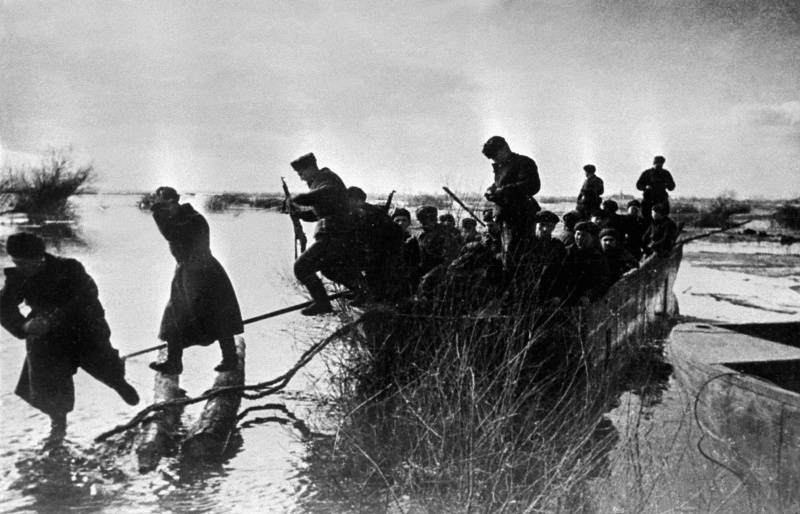
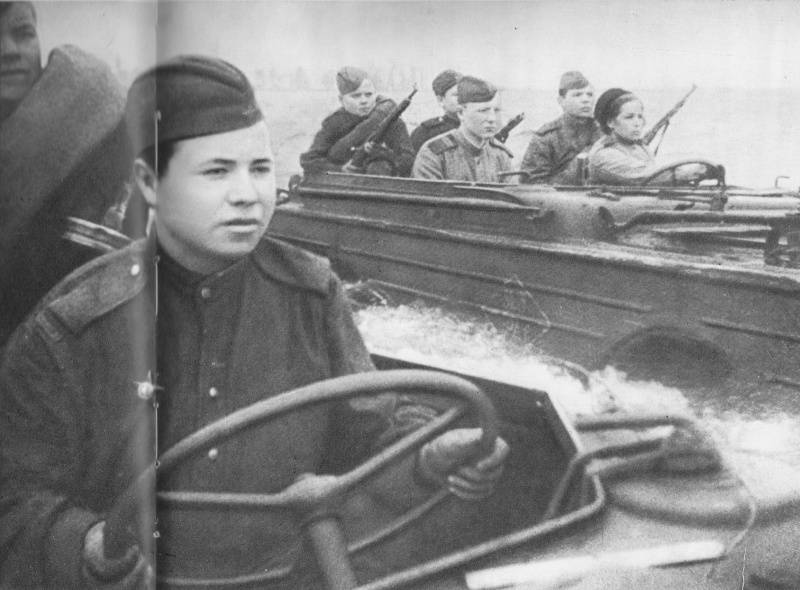
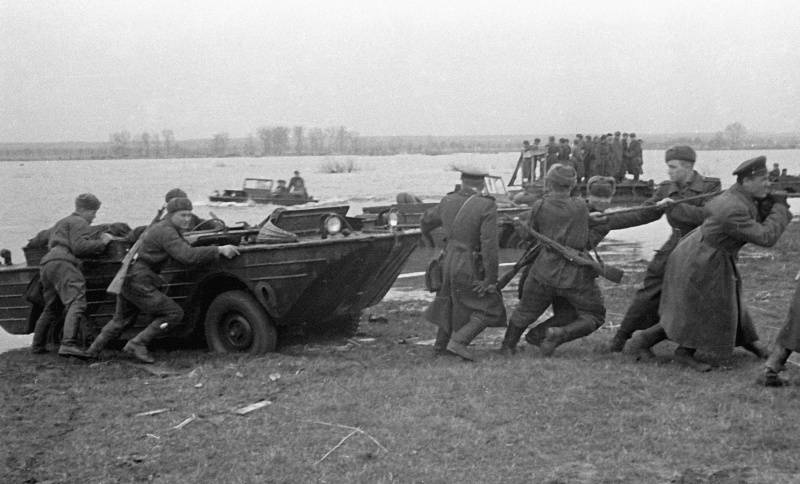
- Alexander Samsonov
- http://waralbum.ru/
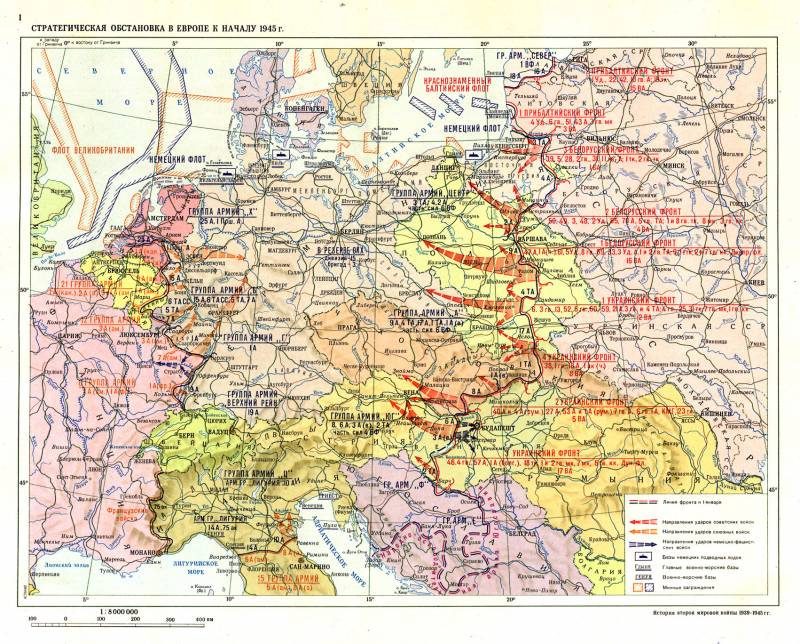
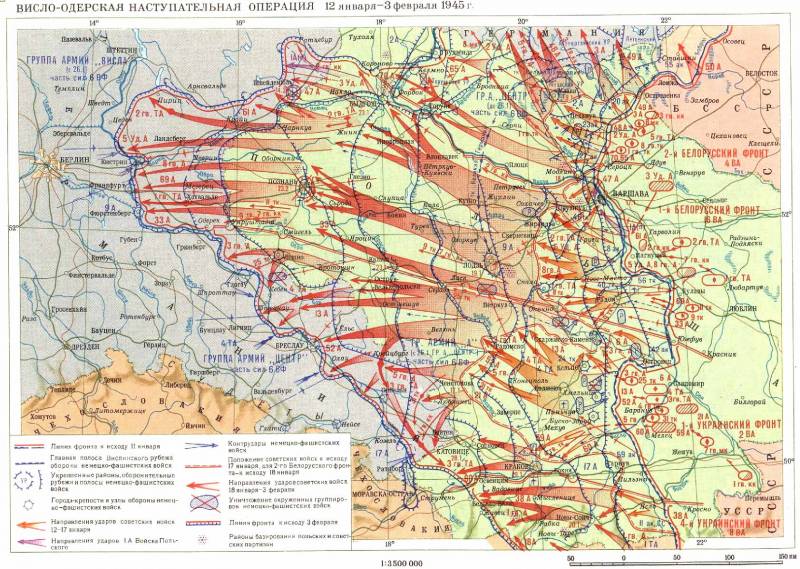
Information